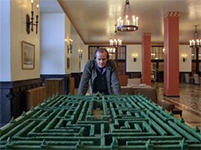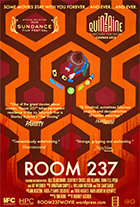Room 237
|  Writing about Stanley Kubrick’s The Shining during its initial theatrical release in 1980, New Yorker film critic Pauline Kael noted sardonically that, if the film “is about anything that you can be sure of, it’s tracking.” Of course, it’s not surprising that Kael would open her review with a dual swipe at both Kubrick’s thematic ambiguity and his technological fetishizing of the newly implemented Steadicam, as she had been one of the noted auteur’s most vocal critics, at least since she called 2001: A Space Odyssey (1968) a “monumentally unimaginative movie.” Writing about Stanley Kubrick’s The Shining during its initial theatrical release in 1980, New Yorker film critic Pauline Kael noted sardonically that, if the film “is about anything that you can be sure of, it’s tracking.” Of course, it’s not surprising that Kael would open her review with a dual swipe at both Kubrick’s thematic ambiguity and his technological fetishizing of the newly implemented Steadicam, as she had been one of the noted auteur’s most vocal critics, at least since she called 2001: A Space Odyssey (1968) a “monumentally unimaginative movie.”Thus, Kael probably wouldn’t have much use for Rodney Ascher’s intriguing new documentary Room 237, which suggests that The Shining is, despite its relentless use of the Steadicam, about a lot more than tracking—a whole lot more, in fact (to be fair, Kael made note of Kubrick’s metaphysical aspirations, his deliberate attempts to mystify the viewer, and how everything in the film—right down to the tracking patterns—are thematic). For fans of Kubrick’s oeuvre and The Shining in particular, Room 237 is a journey down a rabbit hole worth taking, as the film immerses us in alternately fascinating, compelling, absurd, and frightening theories about what, exactly, The Shining is (or might be) about. Far from a boiler-plate adaptation of a best-selling Stephen King novel about the experiences of an isolated family taking care of a possibly haunted hotel during the bleak winter months, Kubrick’s singular horror film is, in the words of the film’s five interviewees, an elaborate puzzlebox of hidden and coded meanings that are ripe for exploration and explanation if you look at the film from just the right angle (or freeze just the right image, or watch it in the proper order, or ...). Of course, the fact that all these theories are in conflict with each other is strong evidence that The Shining’s meaning is in the eye and mind of the beholder, although each interpreter presents his or her understanding of the film as absolute fact—something they are “sure of” and we should be, too. One of the most interesting choices made by Ascher, a commercial and music video director making his feature debut, is the decision to leave the film’s subjects completely off-screen. Thus, even though we hear in detail the personal reminiscences and complex analyses of The Shining presented by Bill Blakemore (a veteran foreign and domestic affairs correspondent), Geoffrey Cocks (a history professor), Juli Kearns (a playwright), John Fell Ryan (a recording artist), and Jay Weidner (an author, filmmaker, and hermetic scholar), we never see their faces. There are no talking-head shots, no traditional interview set-ups—just disembodied voices ruminating over various scenes from The Shining, some of which have to be slowed down frame by frame and zoomed in order for us to see the crucial detail that is, for whoever is speaking, key to the film’s ultimate meaning. In a way, the subjects’ lack of on-screen presence renders them abstract, subsuming their humanity into their fevered interpretations of a horror movie, which makes their analytical endeavors both more fascinating and more ridiculous. Yet, even at their most strained, the theories propounded throughout Room 237 make for compelling intellectual fodder (it’s the kind of film that literally demands a post-screening debate over coffee and cigarettes). The attention to seemingly minute details such as a poster in the background, or the placement of containers on a shelf, or the shift in direction of patterns in the carpet, or the sweater worn by a major character insists that we recalibrate our perception of the cinematic experience, moving inward from the surface narrative into a complex world of hidden-in-plain-sight signs, symbols, and metaphors that may have been purposefully planted (Kubrick was well known to have been fascinated by the use of subliminal advertising) or may be simple coincidence or continuity error. The theories range greatly, and some of them hold our attention because they have genuine merit. For example, the argument that The Shining is at least in part about the genocide of Native Americans has always held some sway in my mind, regardless of which direction those Calumet baking soda cans are pointed in the dry storage room. On the other hand, some of them truly strain credulity, such as the over-the-top notion that Kubrick was indeed involved in faking the moon landing, 2001 was an elaborate test run for the special effects passed off as a major motion picture, and The Shining is actually a coded confession of his secret activities (every conspiracy theorist’s wet dream). It’s all there in little Danny’s USA rocketship sweater, after all. Of course, maybe that was just part of Kubrick’s twisted sense of humor, as he could have very well been toying with the rumors about his moon-landing involvement, of which he was undoubtedly aware. I found myself most intrigued by the seemingly ridiculous, yet gripping proposition that The Shining takes on its true form when simultaneously projected forwards and backwards with the two images superimposed. The manner in which sounds and images from different parts of the film happen to correspond visually and thematically is genuinely eerie, even if in the back of my mind I am quite sure it is call just coincidence. (Or is it?) As should be clear by this point, Room 237 is ] a film for a limited audience of conspiracy theorists and Kubrick fanatics. It will hold little interest for those who haven’t seen The Shining at least once and found themselves baffled, frustrated, and/or enthralled by the way Kubrick took a haunted hotel story (one of the oldest cinematic horror tales in the book, dating back to the silent era of Georges Méliès) and turned it into a philosophical rumination on the eternal nature of human evil and violence (if that’s your interpretation, of course). Ascher, who also edited the film, keeps it consistently lively and engaging, mixing extended clips from The Shining with the humorous deployment of imagery from other Kubrick films (particularly Eyes Wide Shut) to illustrate various points. You might not buy into some or all of what is presented here, but after watching Room 237, I can all but guarantee that you’ll never look at The Shining the same way again. Copyright ©2013 James Kendrick Thoughts? E-mail James Kendrick All images copyright © IFC Films |
Overall Rating: 


 (3.5)
(3.5)


